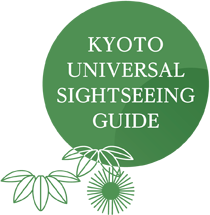【Geisha encounters】
Course for discovering traditional arts of Kyoto

Seseragimichi path
Tatsumibashi bridge
Yasaka Hall Gion Corner
Kennin-ji Temple
Miyagawa-cho
Minamiza Theater
Start!
Keihan Line/Subway Tozai Line Sanjo Station
-

Toilet inside (beyond main tkt barrier) of
Keihan Sanjo Sta.
Public toilet in plaza in front of Keihan Sanjo Sta.
Seseragimichi path
Tatsumibashi bridge
-
This is the bridge crossing the Shirakawa River at Tatsumi Daimyojin (shrine). This is a popular photo spot to show that you have been to Gion. Wheelchair users can get a great view of the river from the bridge. And, if you are lucky, you may seem some carp swimming in the river. Cross the bridge and move into the narrow lane, continue to the end and then turn left.
Yasaka Hall: Gion Corner
-
If you are coming all the way to Kyoto, then you really should take the opportunity to meet a maiko-san (trainee geisha). In an hour-long performance, visitors can see Kyo-mai (Kyoto maiko) i n their charming k imonos performing s even traditional Japanese performing arts, such as chado (tea ceremony), k oto ( Japanese zither) a nd ka do ( flower arranging). The hall also has a gallery with a monthly rotating exhibition of real hairpins with ornamental flowers and other maiko-related items. All in all, this hall offers visitors the chance to see maiko life at close quarters. 
Toilet in Yasaka Hall, Gion Corner 
Carpark toilet at Yasaka Hall, Gion Corner
-
This temple was established by Eisaizenji upon returning to Japan from Sung China in the Muromachi period (1333-1573). It was the first Zen temple in Kyoto. Eisai is famous for introducing tea and the preparation method to Japan. Even today, a tea hedge and stone monument to tea stands in the temple. The abbot's chambers and the Chokushi-mon gate were both built in the Muromachi period. Likewise, the scre en p ainting o f Wind God and Thunder God (Fujin-Raijin-zu) (national treasure) by Sotatsu Tawaraya is very famous. Wheelchair users will require assistance to enter the abbot's chambers as there are a d oorsill and doorframe at the entrance. Also, as the structure is a culture asset, wheels should be wiped before entry. But, once inside, the visitor can view many cultural assets, starting with Fujin-Raijin-zu. The tour route moves on to the Hodo hall and the teahouse "Toyobo", but access is difficult for wheelchairs because of the steps en route. 
Toilet in Hojo building of Kennin-ji Temple
Rokudo Chinno-ji Temple
-
Known affectionately as "Rokudo-san". This temple belongs to the Kenni-ji school of the Rinzai sect. The well here is well known as the one that Ono Takamura used to access the underworld. Also, this temple is famous for "Rokudo Mairi", a period in which worshippers come to the temple to pray for their ancestors during Obon (mid August) each year. In Heian times, Rokudo Chinno-ji Temple faced onto the road that led to the east cemeteries in Toribeno and so the temple is known as the entrance to the other world and this world, or the Rokudo-no-Tsuji (the intersection of six paths to the six realms). And, even to this day, locals believe that the Rokudo intersection is where spirit's lives change to send them on one of the routes: hell, purgatory of hunger, purgatory of animal passion, Asura realm, human realm and heaven. And, as these are the paths of spirits, people come to Rokudo Chinno-ji Temple during Obon to welcome their ancestors.
Miyagawa-cho
-
One street east of Kawabata-dori, this little lane does not get many tourists stepping into to it and it is narrower than Hanamikoji, but, come dusk, the geisha and maiko of Miyagawa-cho tread to and fro through here, adding a real geisha quarter touch.
Minamiza Theater
-
Pop out onto Kawabata-dori from Miyagawa-cho, and go north until you reach the Minamiza Theater. Back in Edo times, some seven theaters had licenses to operate in this area, but now just the Minamiza Theater remains. And, it stands across from the No. 2 entrance to the Keihan Gion Shijo Station.
-
Keihan Gion Shijo Station
-

Toilet inside (beyond south tkt barrier)
Keihan Gion-Shijo Sta.



















